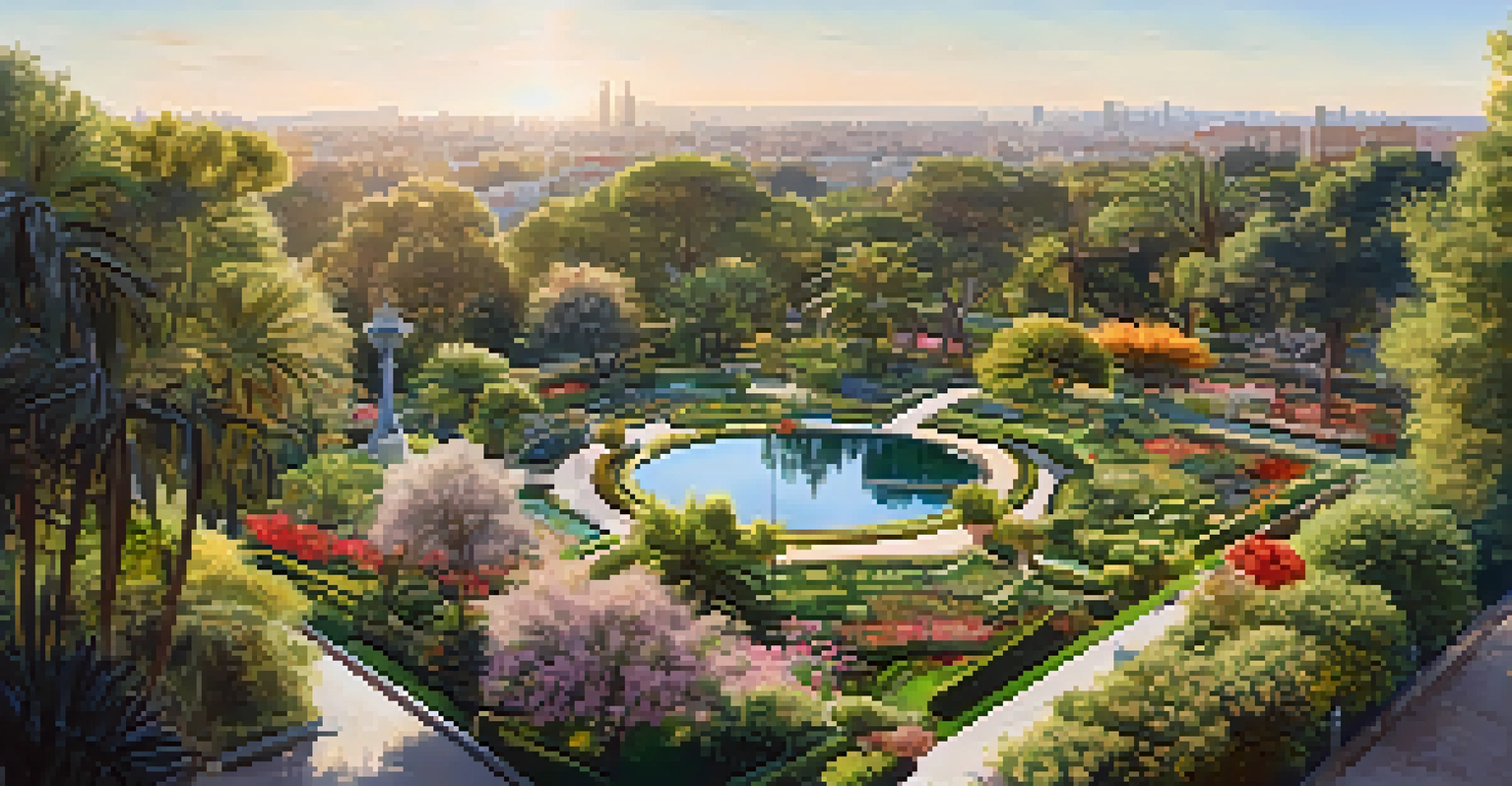The Royal Botanic Garden of Madrid: A Historical Overview

The Origins of the Royal Botanic Garden
The Royal Botanic Garden of Madrid, founded in 1755, has deep historical roots. Originally established to cultivate medicinal plants, it was a vision of King Ferdinand VI. Its initial purpose was to serve as a resource for scientific research and education, reflecting the Enlightenment's emphasis on knowledge and discovery.
The creation of a thousand forests is in one acorn.
Over time, the garden evolved into a repository of diverse plant species from around the world. This transformation was driven by the efforts of renowned botanists and explorers who brought back exotic plants. As a result, the garden became not just a local treasure, but an essential hub for botany in Europe.
Today, the Royal Botanic Garden stands as a testament to centuries of botanical exploration and cultivation. It offers visitors a glimpse into the past while showcasing the beauty and diversity of the plant kingdom. This rich history makes the garden a significant cultural landmark in Madrid.
Architectural Features and Layout
The design of the Royal Botanic Garden is nothing short of stunning, with a layout that harmonizes nature and architecture. The garden spans over 8 hectares and includes numerous paths, ponds, and themed sections. Each area is meticulously planned to not only highlight specific plant species but also to create a serene environment for visitors.

One of the standout features is the majestic neoclassical building that houses the garden's herbarium and library. This building, completed in the 19th century, reflects architectural styles of the time and serves as a hub for research and education. It’s a place where history and science meet, offering insights into botanical studies.
Rich History of Botanical Exploration
The Royal Botanic Garden of Madrid, founded in 1755, has evolved from a medicinal plant repository to a vital center for global botanical research and education.
As you stroll through the garden, you'll encounter a variety of plant collections, including tropical, Mediterranean, and temperate species. The careful arrangement of these collections invites exploration and learning, making each visit a unique experience. The combination of architecture and flora creates an enchanting atmosphere that captivates all who enter.
Key Figures in the Garden's Development
Throughout its history, the Royal Botanic Garden has been shaped by several key figures who contributed to its growth and reputation. Notable botanists like José Celestino Mutis played a crucial role in expanding the garden's collections. Mutis, a Spanish priest and naturalist, led scientific expeditions in South America, bringing back a wealth of botanical knowledge.
Nature does not hurry, yet everything is accomplished.
Another significant figure was the French botanist and landscape architect, Pierre-Joseph Redouté. His artistic depictions of flowers not only enhanced the garden's aesthetic but also helped document the diversity of plant life. His illustrations remain influential in the botanical community today.
These individuals and many others have left an indelible mark on the Royal Botanic Garden. Their contributions have ensured that the garden remains a vital center for botanical research and education. It serves as a reminder of the importance of collaboration in advancing our understanding of the natural world.
The Garden's Role in Conservation
In recent years, the Royal Botanic Garden has taken on a pivotal role in conservation efforts. With the increasing threat of climate change and habitat loss, the garden has become a sanctuary for endangered plant species. Its botanical research aims to protect these species and promote biodiversity.
The garden participates in various conservation programs, collaborating with international organizations. These partnerships focus on preserving genetic diversity and ensuring that endangered plants are cultivated and protected. Through these efforts, the garden contributes to global conservation initiatives.
Significant Role in Conservation
Today, the garden plays a crucial role in conserving endangered plant species and promoting biodiversity through various international collaboration efforts.
Visitors can learn about these conservation activities through educational programs and exhibits. By raising awareness about the importance of preserving plant species, the Royal Botanic Garden inspires future generations to appreciate and protect our natural heritage. It's a place where education and conservation go hand in hand.
Cultural Significance and Public Engagement
The Royal Botanic Garden is more than just a collection of plants; it holds significant cultural importance in Madrid. It serves as a venue for art exhibitions, concerts, and community events, making it a vibrant part of the city's cultural landscape. This engagement fosters a sense of community and connection among visitors.
The garden also offers educational programs for schools and families, emphasizing the importance of nature. Workshops, guided tours, and interactive exhibits help visitors of all ages learn about botany and environmental conservation. This hands-on approach encourages a deeper appreciation for the natural world.
By hosting cultural events and educational activities, the Royal Botanic Garden strengthens its role as a community hub. It invites people to experience nature in a meaningful way, creating lasting memories and fostering a love for the environment. This engagement elevates the garden's status as a cherished public space.
Seasonal Highlights and Events
One of the joys of visiting the Royal Botanic Garden is witnessing its seasonal transformations. Each season brings unique blooms and vibrant colors, making every visit a new experience. In spring, the garden bursts into life with cherry blossoms and tulips, while autumn showcases the fiery hues of changing leaves.
Throughout the year, the garden hosts various events that celebrate its botanical beauty. From flower festivals to guided night walks, these activities invite visitors to engage with nature in different ways. Special seasonal events often highlight specific plants or themes, enhancing the overall experience.
Cultural Hub in Madrid
Beyond its plant collections, the Royal Botanic Garden serves as a vibrant cultural venue, hosting events and educational programs that foster community engagement.
These seasonal highlights not only attract locals but also draw tourists eager to explore Madrid's natural wonders. The Royal Botanic Garden continues to evolve, offering fresh experiences with each passing season. This dynamic environment ensures that there’s always something new to discover, making it a beloved destination.
Visiting the Royal Botanic Garden Today
Today, the Royal Botanic Garden of Madrid is a must-visit destination for both locals and tourists. With its extensive collections and beautiful landscapes, it provides a peaceful escape from the hustle and bustle of city life. Visitors can explore themed gardens, relax by the ponds, or simply take in the stunning views.
The garden also offers a range of facilities to enhance the visitor experience, including a café and a gift shop. These amenities allow guests to enjoy refreshments while soaking in the surroundings. Additionally, informative signage throughout the garden ensures that everyone can learn about the plants and their significance.

Whether you’re a botany enthusiast or simply looking for a tranquil place to unwind, the Royal Botanic Garden has something for everyone. Its rich history, diverse collections, and cultural events make it a unique and enriching experience. A visit to the garden promises both education and enjoyment, making it a highlight of any trip to Madrid.